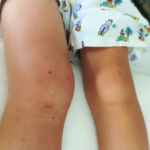 ATLANTA—Managing pediatric patients with rheumatic disease involves special considerations, such as developmental concerns and physiological traits that may affect dosing of medications, according to two experts. During a session at the 2019 ACR/ARP Annual Meeting, Courtney Kremer, ARNP, a pediatric nurse practitioner at the University of Iowa Stead Family Children’s Hospital, Iowa City, and Jessica Lynton, PharmD, a clinical pharmacy specialist at the same center, discussed important aspects to remember when treating young patients. They also reviewed cases and their treatment plans.
ATLANTA—Managing pediatric patients with rheumatic disease involves special considerations, such as developmental concerns and physiological traits that may affect dosing of medications, according to two experts. During a session at the 2019 ACR/ARP Annual Meeting, Courtney Kremer, ARNP, a pediatric nurse practitioner at the University of Iowa Stead Family Children’s Hospital, Iowa City, and Jessica Lynton, PharmD, a clinical pharmacy specialist at the same center, discussed important aspects to remember when treating young patients. They also reviewed cases and their treatment plans.
“It’s a common misconception that pediatric patients will outgrow their rheumatologic disease,” Ms. Kremer said. “Approximately 50% of young adults with JIA [juvenile idiopathic arthritis] will have ongoing, active disease, and it’s not uncommon [for some patients to] have lifelong disease.”
Treatment Considerations
Treatment should be aggressive. When left unchecked, active inflammation can lead to growth disturbances, which have the potential to stunt a patient’s final height and may result in osteopenia and limblength discrepancies, Ms. Kremer said. Aggressive treatment results in better overall outcomes.
When choosing a medication and its dosage, clinicians must consider variations in how it’s absorbed, Dr. Lynton said. The rate and extent of a patient’s organ function and development will affect the drug’s distribution, as well as how it’s metabolized and eliminated.
No simple rule exists for making alterations to adult dosing guidelines for pediatric patients. “The theme that’s important to remember is that the doses can’t just be halved or … decreased,” she said. “Doses are going to vary. And sometimes, those dose requirements can be greater than what we would expect in the adult population.”
Example: 78% of the body weight of a full-term infant is water, but it’s only 60% in adults. Thus, some medications will have a greater volume of distribution in infants and children. Body fat is also much lower in neonates than in adults. Therefore, drugs that are highly lipid soluble will be distributed less widely in infants than in adults.
Case Studies
Case 1: Ms. Kremer presented the case of 6-year-old girl who had a swollen knee for two months that was causing her to limp each morning. She was unable to straighten her right leg, and the knee was warm on physical exam. The girl had a history of camping and tick exposure, but no fevers or illness before the symptoms started, and no family history of autoimmune disease. She had a high erythrocyte sedimentation rate (ESR) and C-reactive protein (CRP) level, and was anti-nuclear antibody (ANA) positive. X-rays showed effusion, but no lesions or erosions.

